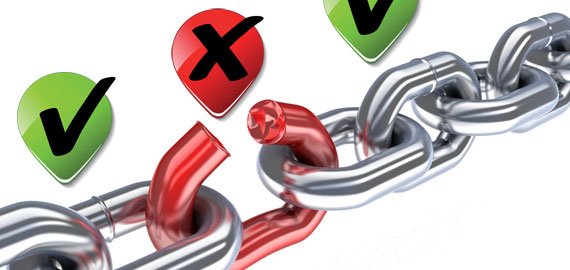
Why are backlinks disavowed important for web-optimizers? When to disavow backlinks? Let’s get started. We keep building backlinks and hope they help our website rank better on SERPs. However, some backlinks can do more harm than good to your website. These backlinks are called “toxic backlinks” and need to be disavowed.
This blog post will cover everything you need about disavowing links using Google’s Disavow Links Tool. We will discuss what disavowed in SEO means, how the disavow tool can help with SEO, and when you might want to use it. We will also show you how to find and disavow backlinks using two different tools. So, this blog post is for you, whether you are just getting started with SEO or have been working in the field for years!
What Is Disavowed In SEO?

“Disavow” in SEO means telling Google you do not want a particular backlink to count towards your website’s link profile. You do this by adding the backlink to a disavow file and submitting it to Google via Search Console.
What Is Google’s Disavow Links Tool?

Google’s Disavow Links Tool is a free tool that allows web admins to disavow backlinks from their sites. This can be helpful if you believe some of the backlinks pointing to your site harm your SEO efforts.
Why Might You Want To Disavow Backlinks?
There are several reasons why you might want to disavow backlinks. The three most common reasons are listed below:
- It can help you recover from a manual penalty. If you have been hit with a manual penalty, it is because Google has found that you are violating their guidelines. This could be because of spammy backlinks pointing to your site.
- Disavowing backlinks can help your website by preventing an algorithmic penalty. Google’s algorithm automatically applies algorithmic penalties, usually resulting from toxic backlinks pointing to your site. By disavowing these backlinks, you tell Google that you did not create them and should not be counted against your website.
- It can help to remove toxic backlinks from your site’s link profile. Toxic backlinks are created for the sole purpose of harming your website’s SEO. They can come from spammy websites or be part of a negative SEO campaign against your website.
By disavowing these backlinks, you can help to protect your website from harm.
How To Find Which Links To Disavow?

You can find backlinks that you might want to disavow in two ways.
- The first way is to use a free tool like Google Search Console. This will show you all the backlinks pointing to your site, both good and bad.
- The second way is to use a paid tool like PadiTool. This tool will give you more information about each backlink, including whether or not it is toxic.
A few Paid Tools To Backlinks Disavow Are:
- Ahrefs
- Semrush
How To Find Harmful Links In Google Search Console (Free Tool)?
If you want to find backlinks that might harm your website, you can use Google Search Console. This is a free tool provided by Google. Add your website to the Search Console and click the “Links” tab. Here, you will see all the backlinks pointing to your site. You can then click on the backlink to get more information about it.
How To Find Harmful Links In Ahrefs (Paid Tool)?
If you want to find backlinks that might harm your website, you can use Ahrefs. This paid tool will give you more information about each backlink, including whether or not it is toxic with other metrics such as Domain Rating (DR) & Spam Score.
To use a simple, create an account and add your website. Then click the “Backlinks” tab to see all the backlinks pointing to your site. You can then click on the backlink report to get the download.
How To Find Harmful Links In Semrush (Paid Tool)?
This is the second paid tool for finding backlinks that might harm your website. Semrush gives information about each backlink, such as Domain Rating (DR), Spam Score, Link Type, and Anchor Text.
To use, create an account and add your website. Then click on the “Backlinks” tab to see all the backlinks pointing to your site. You can then click on the download report button to use it offline.
How To Disavow Backlinks In Google Search Console?
You might have added your site to the Google search console, which has been verified. If not, we suggest you do so right away.
Now, follow the step-by-step guide to disavow backlinks using Google Search Console.
Step #01: Go To The Links Tab And Click “More”
Once the site is verified, you can see all the backlinks pointing to your website. Go to the “Links” tab and click “More.”
Step #02: Download The Backlink Report
Once you are on the “backlink” page, you will see an option to download the backlink report data into an Excel spreadsheet. This report will contain all the backlinks pointing to your site. We suggest you download this report so that you can reference it later.
Once the report is downloaded, you can manually apply filters such as “do follow” or “no follow” backlinks, backlinks with high DA scores, Fewer DA scores, Spam scores (high/less), etc. This will quickly sort out your harmful backlinks.
Step #03: Create Your Disavow Backlinks .txt File
Now that you have downloaded the backlink report, it’s time to create your disavow backlinks .txt file. You will upload this file to Google Search Console later.
To create simple, open a new text document and save it as “disavow backlinks.txt.” you’ll want to assemble all the backlinks you want to disavow into a .txt file.
You’ll put each disavow rule in its line.
To target individual pages, you must paste the full URL to the page, including the HTTPS part.
The same goes for the part of the domain.
To target entire domains, you need to use this format: domain: spammy site.c.om
Here’s an example of what the .txt file would look like – this would disavow backlinks from three specific pages and two domains:
- https://xyzexamples.com/read/
- https://xyzexamples.com/articel/how-to
- domain: spammysite.com
- domain: anotherexamplespammysite.com
Here Are Some Other Essential Details About The .txt File:
- The filename must end in .tats.
- Make sure to encode the file in UTF-8 or 7-bit AS. You cannot use other formats.CII.
- The maximum file size is 100,000 lines, including blank lines and comments. This means you can disavow up to 100,000 links/domains. There’s also a limited file size, i.e., 2 MB max.
- You can include comments by using the # mark. Google will ignore these, but you might find them helpful while working on the file.
Step #04: Submit Your File Via Google Search Console
Once you’ve created your .txt file, it’s time to upload it to Google Search Console. Here’s how you can do it:
Select your website (“property”) from the drop-down.
Click the “Upload Disavow list” button to upload the disavow backlinks file you created in the previous st. ep
Once the file is uploaded, the links should appear in the interface, and you are done from your end.
Note: If you have previously disallowed any links from the same property, upload a new .txt file that may replace the existing one.
Now that you know how to disavow backlinks, there are some essential things that you need to keep in mind:
The disavow list will only apply to the specific property that you chose. If you have separate properties for the “HTTP” and “HTTPS,” You’ll need to upload the disavow list for both site versions.
The disavow backlinks tool is only meant for advanced users. If you are new to SEO, we suggest you avoid using this tool. Before disavowing any links, check if the links are genuinely harmful. You can check the anchor text, DA score, and other factors.
If you have a manual penalty from Google, it is best to contact them and resolve the issue before using the disavow backlinks tool.
Step #05: Wait For A Few Weeks
The backlinks disavowed will not work instantly. It can take weeks for Google to factor this information into its rankings. You should see a decrease in backlinks over time as Google recrawls the web and applies your disavowal requests.
Risk Involved In Backlinks Disavow
While the backlinks disavow is a powerful tool, it should be used cautiously. If not used correctly, it can backfire and harm your website more than reasonable.
Here are five risks involved in backlinks disavow:
You Might Unintentionally Disavow Some Good Backlinks
If you are new to SEO, you might end up disavowing some good backlinks. So, before using this tool, ensure you know what you’re doing.
Your Rankings Might Drop
If you have been hit with a Google penalty and have used the backlink disavow tool to remove the toxic links, your rankings may drop further. This is because when you remove the bad backlinks, the good backlinks also get removed.
Your Website Might Get De-Indexed
If you have used the backlink disavow tool to remove all the backlinks to your website, Google might de-index your website. So, use this tool with caution.
Backlinks Disavow A Time-Consuming Process
The backlinks disavow tool is not a quick fix. It can take weeks or months for Google to consider your disavowed backlinks. So, if you’re looking for a quick fix, this tool is not for you.
There’s No Guarantee That Your Website Will Recover
Even if you have used the backlink disavow tool correctly, there’s no guarantee that your website will recover from the Google penalty. So, use this tool at your own risk.
Now that you know everything about backlinks disavow, we suggest you use this tool only if you are sure about what you’re doing.
Alternative Of Google Disavow Tool?
If you want to disavow backlinks but don’t want to use Google’s disavow backlinks tool, there are some alternatives that you can try.
One such alternative is the Bulk Disavow Links Tool by Moz. This tool lets you upload a list of backlinks you want to disavow. Once the backlinks are uploaded, SEOmoz will send a request to Google to disavow the links.
Another alternative is the Disavow Backlinks Tool by CognitiveSEO. This tool allows you to upload a list of backlinks and then send a request to Google, asking them to disavow the links.
Both these tools are easy to use and can help you disavow backlinks without using Google’s disavow backlinks tool.
FAQs
Q1: How Long Does It Take For Backlinks To Be Disavowed?
Ans: It can take weeks for backlinks to be disavowed. Google needs to recrawl the web and apply your disavowal requests.
Q2: How Do I Know If My Backlinks Have Been Disavowed?
Ans: You can check the number of backlinks in the Google Search Console. If the number of backlinks decreases over time, your backlink requests have been processed.
Q3: What Happens If I Disavow A Backlink?
Ans: If you disclaim a backlink, Google will stop considering that link when calculating your website’s rankings.
Q4: Are There Any Risks To Using The Disavow Tool?
Ans: So, the answer is yes. If you are new to SEO, we suggest you avoid using this tool, as you might disavow backlinks that are not genuinely harmful, which could hurt your website’s ranking.
Conclusion
Now, you might have a clear picture of backlinks to disavow, like what backlinks disavow are, when to disavow backlinks, what risks are involved in disavowing, etc. So be careful before using the backlinks disavow tool, as it may harm your website’s ranking if misused.
The above guide about backlink disavowing might have cleared all your doubts. So, think twice before using this tool; only if you know what you’re doing.
If you have further questions, please write in the comment section. We’ll be happy to answer all your questions regarding backlink building.


